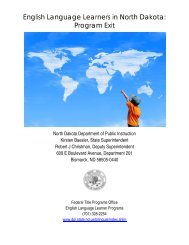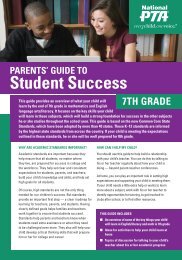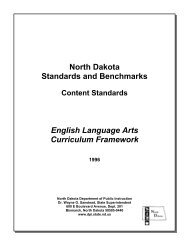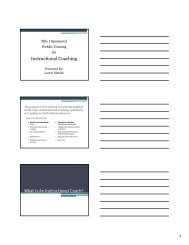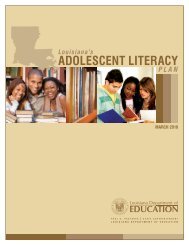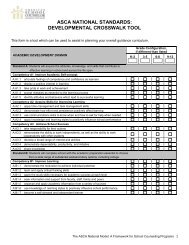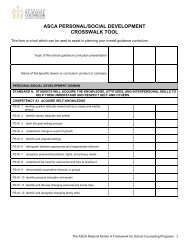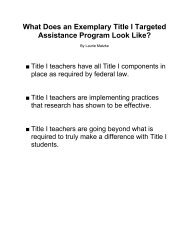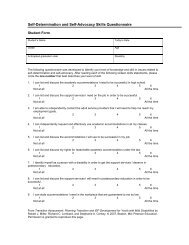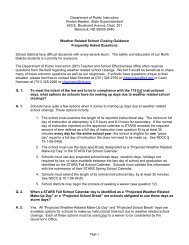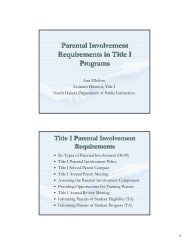Coordinated Set of Needed Activities/Strategies Examples
Coordinated Set of Needed Activities/Strategies Examples
Coordinated Set of Needed Activities/Strategies Examples
You also want an ePaper? Increase the reach of your titles
YUMPU automatically turns print PDFs into web optimized ePapers that Google loves.
2<br />
Suggested Transition <strong>Activities</strong>/<strong>Strategies</strong> for<br />
“Instruction”<br />
<strong>Activities</strong>/strategies listed in this area have to do with “instruction,” whether that is a formal or<br />
informal imparting <strong>of</strong> knowledge or skills. The activities/strategies can include, but are not<br />
limited to, such things as:<br />
1. Complete a learning styles inventory to identify preferences and strength modes<br />
2. Collect information regarding the student’s desired postsecondary educational involvement<br />
3. Visit college campuses and meet with student support services<br />
4. Enrollment in a tech-prep program<br />
5. Learn about Section 504 <strong>of</strong> the Rehabilitation Act and Americans with Disabilities Act<br />
6. Explore admission requirements for possible part-time enrollment at a Vocational/Technical School<br />
7. Learn about the process for accessing apartments for rent<br />
8. Obtain information on continuing adult education opportunities<br />
9. Enroll in Self-Advocacy/Self-Awareness Studies<br />
10. Enroll in career and vocational education/vocational English<br />
11. Take occupation specific courses<br />
12. Enroll in an adult living course<br />
13. Enroll in an internship/apprenticeship program<br />
14. Participate in extra curricular activities such as __________<br />
15. Enroll in Adult/Continuing Education courses such as __________<br />
16. Enroll in Community College courses such as __________<br />
17. Enroll in parenting classes<br />
18. Learn financial management-money skills<br />
19. Learn about time management<br />
20. Practice negotiation skills for job raises, car purchases, etc.<br />
21. Access tutoring services in school or through a private agency<br />
22. Write an information interview letter to the disabilities resource coordinator at a postsecondary school<br />
<strong>of</strong> interest<br />
23. Take a GED pre-test<br />
24. Take a CPR/First Aid course<br />
25. Enroll in a SAT prep course<br />
26. College prep: courses, ACT/SAT, application<br />
27. Learn about community agencies that provide services and support to people with disabilities<br />
28. Tour post school occupational training programs<br />
29. Obtain, complete, and submit applications to colleges <strong>of</strong> choice<br />
30. Research college scholarship opportunities<br />
31. Obtain, complete, and submit applications for tuition assistance programs<br />
32. Enroll in and take classes through the local County Extension Program<br />
33. Special Education supports in identified classed<br />
34. Apply for and take ACT testing with accommodations.<br />
35. Take Transportation Mobility courses<br />
36. Learn and practice self-advocacy<br />
37. Develop work readiness skills and vocational English<br />
38. Learn about and practice social skills<br />
39. Learn about and practice communication skills<br />
40. Learn about the decision making process and practice the skills<br />
41. Develop Crisis Management skills<br />
42. Take driver’s education<br />
Adapted from Helping Educators, Parents and Other Stakeholders Understand: Postschool Outcomes,<br />
Course <strong>of</strong> Study and <strong>Coordinated</strong> <strong>Set</strong> <strong>of</strong> <strong>Activities</strong> by Ed O’Leary and Wendy Collison, 2002




